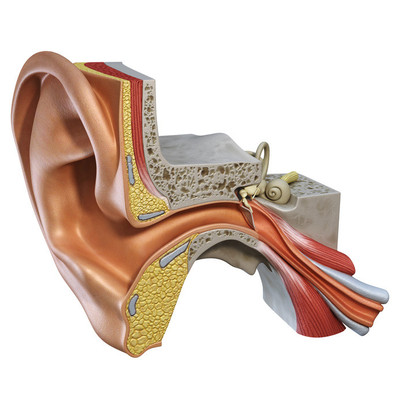Researchers develop wirelessly rechargeable cochlear implants
MIT researchers have developed a new, low-power signal-processing chip that could lead to a cochlear implant that requires no external hardware. The implant would be wirelessly recharged and would run for about eight hours on each charge.
Existing cochlear implants use an external microphone to gather sound, but the new implant would instead use the natural microphone of the middle ear, which is almost always intact in cochlear-implant patients.
The researchers’ design exploits the mechanism of a different type of medical device, known as a middle-ear implant. Delicate bones in the middle ear, known as ossicles, convey the vibrations of the eardrum to the cochlea, the small, spiral chamber in the inner ear that converts acoustic signals to electrical. In patients with middle-ear implants, the cochlea is functional, but one of the ossicles - the stapes - doesn’t vibrate with enough force to stimulate the auditory nerve. A middle-ear implant consists of a tiny sensor that detects the ossicles’ vibrations and an actuator that helps drive the stapes accordingly.
The new device would use the same type of sensor, but the signal it generates would travel to a microchip implanted in the ear, which would convert it to an electrical signal and pass it on to an electrode in the cochlea. Lowering the power requirements of the converter chip was the key to dispensing with the skull-mounted hardware.

The idea with this design is that you could use a phone, with an adaptor, to charge the cochlear implant, says Anantha Chandrakasan, the Joseph F and Nancy P Keithley Professor of Electrical Engineering and corresponding author on the new paper to be presented at the International Solid-State Circuits Conference. The paper’s lead author - Marcus Yip, who completed his PhD at MIT last year - and his colleagues Rui Jin and Nathan Ickes, both in MIT’s Department of Electrical Engineering and Computer Science, will also exhibit a prototype charger that plugs into an ordinary cell phone and can recharge the signal-processing chip in roughly two minutes.
Chandrakasan’s lab at MTL specialises in low-power chips, and the new converter deploys several of the tricks that the lab has developed over the years, such as tailoring the arrangement of low-power filters and amplifiers to the precise acoustic properties of the incoming signal.
Chandrakasan and his colleagues also developed a new signal-generating circuit that reduces the chip’s power consumption by an additional 20 to 30%. The key was to specify a new waveform - the basic electrical signal emitted by the chip, which is modulated to encode acoustic information - that is more power-efficient to generate but still stimulates the auditory nerve in the appropriate way. The waveform was based on prior research involving simulated nerve fibres, but the MIT researchers tailored it for cochlear implants and found a low-power way to implement it in hardware. Two of their collaborators at MEEI - Konstantina Stankovic, an ear surgeon who co-led the study with Chandrakasan, and Don Eddington - tested it on four patients who already had cochlear implants and found that it had no effect on their ability to hear.
A fluid battery that can take any shape
Using electrodes in a fluid form, researchers have developed a battery that can take any shape.
Key factors to consider with fire protection for an EV battery
This article explores some factors for EV battery designers to consider when deciding on...
Researchers claim record PV efficiency for kesterite solar cell
UNSW researchers have reportedly set a new record for a kesterite solar cell, which could be a...





